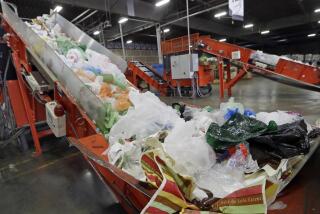P&G hopes to develop recyclable diapers in battle against waste

- Share via
Procter & Gamble Co., facing an industrywide backlash against consumer waste, is seeking a patent that would help it develop recyclable versions of absorbent products including diapers, sanitary products and even cleaning wipes.
Because many absorbent products today use multiple kinds of plastic and other materials, they’re hard to separate during trash sorting and nearly always end up in landfills, the consumer products giant said in its patent application, published last week. By reducing the number of components and using more sustainable ones, P&G said it could simplify the separation process and make the recycling of single-use goods more feasible.
“The more materials to be separated in the absorbent article recycling operation, the more complex and expensive the recycling operation becomes,” it said in the patent application. “The proliferation of regulations limiting landfill waste, along with rising costs, have made traditional disposal of waste in landfills less desirable.”
A spokeswoman for P&G didn’t have an immediate comment.
Environmentally conscious customers are asking for new ways to reduce their carbon footprints. More than 80% of global respondents feel strongly that companies should help improve the environment, according to Nielsen data from 2018.
Younger generations of Americans say they’d be willing to pay more for a product if they knew the brand supported environmental initiatives, a survey by Bloomberg and Morning Consult found.
Of course, the complex layers in today’s diapers and pads aren’t the only deterrent to recycling. A large share of absorbent products are used to dispose of biological waste like blood or urine, and municipalities or private operators would likely need specific infrastructure and new processes to be able to recover high-value material to be made into new products. P&G’s patent application didn’t explain how it would deal with that obstacle.
“These products won’t be recyclable in a curbside recycling stream, given the use and contamination that will exist afterward,” said Bridget Croke, the vice president of external affairs at Closed Loop Partners, an investment firm focused on creating a circular economy. “That said, we’re seeing a lot of innovation on the product design and infrastructure side to make sure as much material can be recovered as possible.”
The development of recyclable absorbent products is in part motivated by the rising cost of traditional trash disposal. Wet wipes, for example, tend to collect in sewer lines and form masses known as fatbergs that cost U.S. municipalities about $1 billion a year. P&G mentioned unspecified “wipes” in the patent application.
Recyclable absorbent materials would also let companies lower their reliance on petroleum-based polymers made from fossil fuels.
“Given there may be a limited amount of petroleum in the world, it is prudent to create absorbent articles which are more readily recycled, are designed for simple recycling, or designed to be friendly in a recycling operation,” P&G said.
As part of P&G’s “Ambition 2030” plan, which includes cutting greenhouse gas emissions in half, the company formed a partnership with Italian pharmaceutical company Angelini Group to turn diapers into secondary goods like bottle caps. P&G plans to have the recycling practice operational in 10 cities by 2030, according to its website.
More to Read
Inside the business of entertainment
The Wide Shot brings you news, analysis and insights on everything from streaming wars to production — and what it all means for the future.
You may occasionally receive promotional content from the Los Angeles Times.










